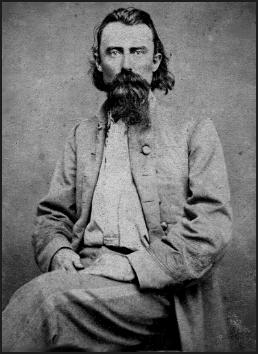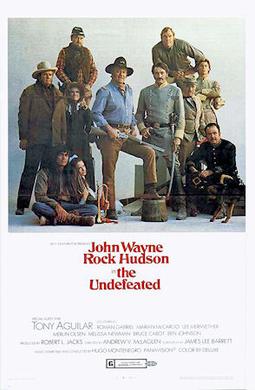Plot
Following General Lee's surrender, Colonel Lafe Harvey, CSA returns to the family plantation to inform his niece Betty Lee that her father, General John Harvey, CSA was killed in a river during a battle. At that moment former guerillas have turned to brigandage where they attack and burn the plantation. Col. Harvey shoots one of them who attempt to attack a female slave. After the skirmish, where their plantation home has been burned to the ground, the Colonel and Betty Lee inform the freed slaves that they will take a wagon train to the West.
Shortly afterwards, Union Army Lieutenant Ted Thorn brings a blinded General Harvey home, as one last favour, the General asks Ted the inform his brother and his daughter of his return. The General does not know the man who saved his life was a Union officer until one of the ex-slaves tells him so.
Lt. Thorn meets President Abraham Lincoln who promotes him to Captain in the US Army and sends him on an undercover mission to stop a new republic from being formed in the West. The same former guerrillas who burned the Harvey plantation are amongst the plotters who consort with the Indians to act as a buffer state for them.
The Battle of Cotton Plant also known as Action at Hill's Plantation or Action at Cache River or Action at Round Hill was fought during the American Civil War in Woodruff County, Arkansas. Frustrated in its attempt to march to Little Rock by a lack of supplies, the Union Army of the Southwest under the command of Samuel Ryan Curtis moved south down the White River. Curtis's army encountered a Confederate force led by Albert Rust on the east bank of the Cache River near Cotton Plant. Rust was only able to bring two Texas cavalry regiments into action. These horsemen attacked the Federal advance guard under Charles Edward Hovey, but after a spirited fight, Union reinforcements arrived and drove off the Texans. Rust's force made a disorderly retreat and Curtis's army was able to march south to Clarendon before veering east to occupy Helena on the Mississippi River.

James Walker Fannin Jr. was an American military officer, planter, and slave trader who served in the Texian Army during the Texas Revolution. After being outnumbered and surrendering to the Mexican Army at the Battle of Coleto Creek, Fannin and his fellow prisoners of war were massacred soon afterward at Goliad, Texas, under Antonio López de Santa Anna's orders. He was memorialized in several place names, including a military training camp and a major city street in Houston.

John Daniel Imboden, American lawyer, Virginia state legislator, and a Confederate army general. During the American Civil War, he commanded an irregular cavalry force. After the war, he resumed practicing law, became a writer, and was active in land development founding the town of Damascus, Virginia.

The Powder River Expedition of 1865 also known as the Powder River War or Powder River Invasion, was a large and far-flung military operation of the United States Army against the Lakota Sioux, Cheyenne, and Arapaho Indians in Montana Territory and Dakota Territory. Although soldiers destroyed one Arapaho village and established Fort Connor to protect gold miners on the Bozeman Trail, the expedition is considered a failure because it failed to defeat or intimidate the Indians.

Joseph Orville "J.O." Shelby was a Confederate officer who commanded cavalry in the Trans-Mississippi Theater of the American Civil War. After the Confederacy surrendered, Shelby tried to swear fealty to Emperor Maximilian I during the French invasion of Mexico. With the Emperor's permission, Shelby formed a colony of Confederate exiles in Mexico until the defeat of the French, then abandoned the operation.
The Battle of Jenkins' Ferry, also known as the Engagement at Jenkins' Ferry, was fought on April 30, 1864, at Jenkins' Ferry, southwest of Little Rock, during the American Civil War. Although the battle ended with a Union victory, the Confederates saw it as a strategic success as they claimed to have prevented Frederick Steele from holding southwest Arkansas. Due to the chaotic nature of the battle, casualty figures vary.

The Battle of Cumberland Church was fought on April 7, 1865, between the Union Army's II Corps of the Army of the Potomac and the Confederate Army of Northern Virginia during the Appomattox Campaign of the American Civil War.
The Battle of Appomattox Station was fought between a Union Army cavalry division under the command of Brigadier General George Armstrong Custer and Confederate Army of Northern Virginia artillery units commanded by Brigadier General Lindsay Walker with support from some dismounted cavalrymen, artillerymen armed with muskets and some stragglers on April 8, 1865, at Appomattox Station, Virginia during the Appomattox Campaign of the American Civil War.
The Starbuck Chronicles are a series of historical fiction novels by British author Bernard Cornwell set during the American Civil War. They follow the exploits of Boston-born Confederate officer Nathaniel Starbuck.

North and South is the title of three American television miniseries broadcast on the ABC network in 1985, 1986, and 1994. Set before, during, and immediately after the American Civil War, they are based on the 1980s trilogy of novels North and South by John Jakes. The 1985 first installment, North and South, remains the seventh-highest rated miniseries in TV history. North and South: Book II (1986) was met with similar success, while 1994's Heaven and Hell: North and South Book III was poorly received by both critics and audiences.

Francis Marion Drake was an American merchant, lawyer, banker and politician. He fought in the American Civil War and later became the 16th Governor of Iowa. He is the namesake of Drake University.

The 1st West Virginia Cavalry Regiment served in the Union Army during the American Civil War. Although it started slowly, it became one of the most active and effective of the West Virginia Civil War regiments—and had 14 Medal of Honor recipients, the most for any West Virginia regiment during the war. It was originally called the 1st Virginia Cavalry, not to be confused with the Confederate 1st Virginia Cavalry. Some reports added "Union," "Loyal" or "West" when identifying this regiment. After the Unionist state of West Virginia was officially admitted to the Union in 1863, the regiment became the 1st West Virginia Cavalry Regiment. The National Park Service identifies it as the 1st Regiment, West Virginia Cavalry.

The Undefeated is a 1969 American Western and Civil War-era film directed by Andrew V. McLaglen and starring John Wayne and Rock Hudson. The film portrays events surrounding the French Imperial intervention in Mexico during the 1860s period of the neighboring American Civil War. It is also loosely based on Confederate States Army General Joseph Orville Shelby's factual escape to Mexico after the American Civil War (1861–1865), and his attempt to join with Maximilian's Imperial Mexican forces.

Two Flags West is a 1950 Western drama set during the American Civil War, directed by Robert Wise and starring Joseph Cotten, Jeff Chandler, Linda Darnell, and Cornel Wilde. The opening credits contain the following statement:
On December 8th, 1863, President Abraham Lincoln issued a Special Proclamation, whereby Confederate Prisoners of War might gain their freedom, provided they would join the Union Army to defend the frontier West against the Indians.
The Battle of Yellow Bayou, also known as the Battle of Norwood's Plantation, saw Union Army forces led by Brigadier General Joseph A. Mower clash with Confederate States Army troops commanded by Brigadier General John A. Wharton in Avoyelles Parish, Louisiana during the American Civil War. This was the final action of the Red River campaign in which a Union army under Major General Nathaniel P. Banks was repulsed by Confederate forces led by Major General Richard Taylor. The failed Union campaign almost ended in disaster when an accompanying Union fleet led by Rear Admiral David Dixon Porter was trapped at Alexandria, Louisiana, by low water in the Red River. An engineering feat saved the fleet, allowing Banks' army to complete its withdrawal.
The 36th Iowa Infantry Regiment was an infantry regiment that served in the Union Army during the American Civil War.

The 2nd Maryland Cavalry Battalion, a.k.a. Gilmor's Partisan Rangers, was a Confederate unit in the American Civil War.
The Battle of Marks' Mills, also known as the Action at Marks’ Mills, was fought in present-day Cleveland County, Arkansas, during the American Civil War. Confederate Brigadier-General James F. Fagan, having made a forced march, attacked a train of several hundred wagons, guarded by a brigade of infantry, 500 cavalry, and a section of light artillery under command of Lieutenant-Colonel Francis M. Drake of the 36th Iowa, on its way from Camden to Pine Bluff for supplies.
The Skirmish at Terre Noire Creek, also known as the Skirmish at Wolf Creek or Skirmish at Antoine, an engagement during the Camden Expedition of the American Civil War, was fought on April 2, 1864. The action occurred about 1 mile (1.6 km) east of Terre Noire Creek along a defile near the towns of Hollywood, Arkansas and Antoine, Arkansas. A Confederate States Army cavalry brigade under Brigadier General Joseph O. Shelby attacked a Union supply train of more than 200 wagons accompanying Union Army Major General Frederick Steele's force which was attempting to reach Shreveport, Louisiana to join with Major General Nathaniel Banks's force in the Red River Campaign with the objective of occupying Shreveport and controlling western Louisiana.

Steele's Greenville expedition took place from April 2 to 25, 1863, during the Vicksburg campaign of the American Civil War. Union forces commanded by Major General Frederick Steele occupied Greenville, Mississippi, and operated in the surrounding area, to divert Confederate attention from a more important movement made in Louisiana by Major General John A. McClernand's corps. Minor skirmishing between the two sides occurred, particularly in the early stages of the expedition. Over 1,000 slaves were freed during the operation, and large quantities of supplies and animals were destroyed or removed from the area. Along with other operations, including Grierson's Raid, Steele's Greenville expedition distracted Confederate attention from McClernand's movement. Some historians have suggested that the Greenville expedition represented the Union war policy's shifting more towards expanding the war to Confederate social and economic structures and the Confederate homefront.












